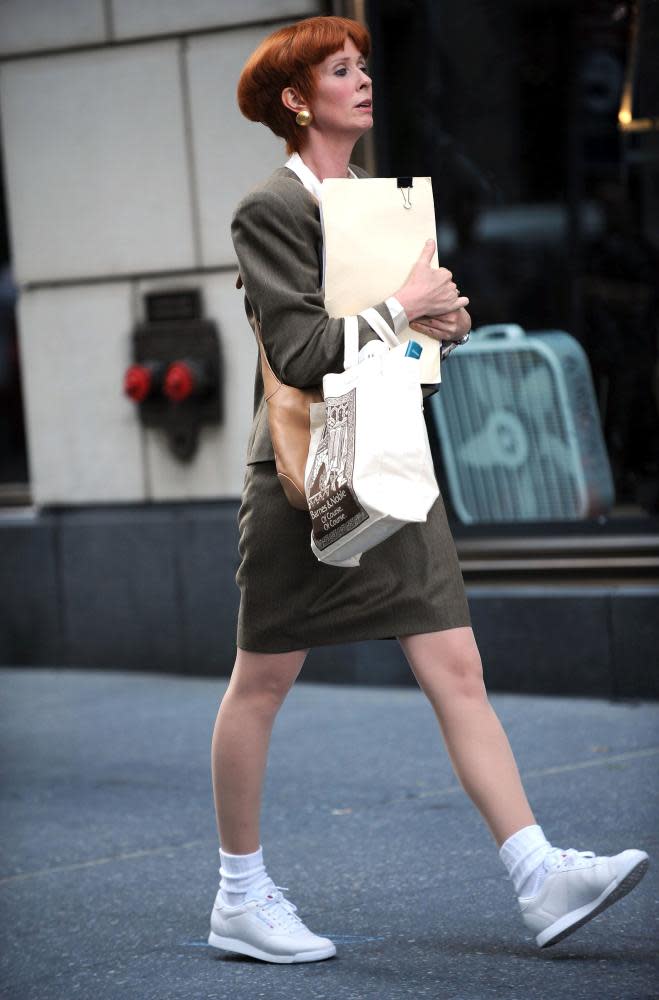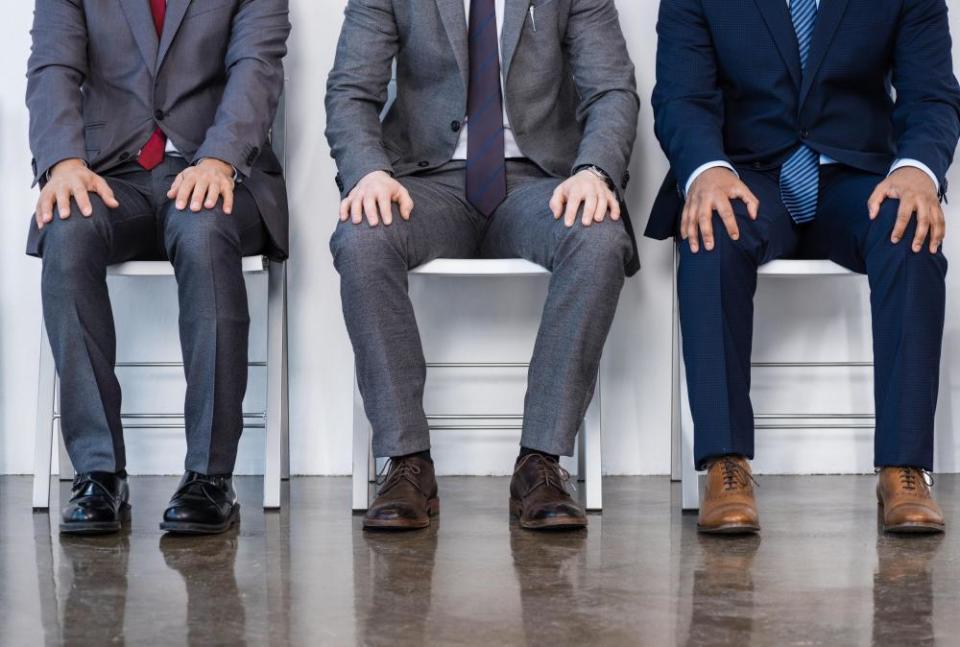All heel and no sole: has lockdown put an end to the under-desk shoe?
Laura Whiston refers to her collection of heels as “an expensive museum that I occasionally visit”. Whiston has a job in television but, like many people, has been working from home since the beginning of the lockdown. During that time, she has rarely, if ever, worn heels. “I made a catalogue because I kept forgetting what I had,” she says. “The only time I wore [heels] anyway was at work, and even then I’d wear flats for the commute. I always had a stash under my desk just in case .”
Fast forward to July 2020, and Laura’s under-desk shoe stash has become a symbol of simpler times, the Dead Sea Scrolls of an office-life now gathering dust alongside the cheese plants and canteen mugs of life Before Covid. If you have worked in an office, you almost certainly have a few pairs yourself – usually mid-priced heels, in black or beige, which balanced safe smartness with public-facing dullness, as well as the split between the work you and the real you. It’s like they say, heavy is the shoe that you only wear at work.
The “under-desk shoe” rose to prominence in the 1980s, as both a product of women entering the corporate world, and a reminder of the journey, actual and metaphorical, that they took to get there. See Melanie Griffith as Tess McGill in Working Girl, a symbol of the 1980s New York office commuter, and Cynthia Nixon as Miranda Hobbes in Sex and the City, at the turn of the millennium. Both travel to work in white trainers and tube socks, both change into heels they keep under the desk and both are trying to navigate a world once – still, really – dominated by men, while meeting stringent dress-codes geared primarily towards them. As Germaine Greer memorably said: “If she never takes off her high-heeled shoes, how will she ever know how far she could walk or how fast she could run?”
Christina Kimeze used to work in the city, where smart shoes were a requisite of the job. There was a strict dress code, enshrined in a booklet handed out to every new employee. It was a code Kimeze internalised with an enthusiasm that she now finds amusing. “At the start, I used to travel in wearing them… Then I got less enthusiastic and progressed to wearing them only in the office. The space under my desk was overflowing with heels. When I left my job, clearing them out involved a good few carrier bags.” Now self-employed, Kimeze wears trainers . The under-desk shoes she once wore are now, for her, relics of a lost time. All of which begs the question: what has happened to all those shoes, gathering dust under desks across the nation?
“Desks were just abandoned. It was eerie,” says Frances Grace, who works in the public sector. As a key worker, she went into her office for most of lockdown, and was privy to what people left behind: “People just walked away and left behind their work shoes, their comfy shoes, their family photos, all to collect dust.” It’s almost as if no one actually wanted them in the first place.
At a former job, we knew the work day had started when we heard the clackety-clack of the editor walking across the hard floors in her navy patent Kurt Geigers, or black LK Bennetts. As far as we were concerned, she came to work in heels and her under desk was empty. One day, I arrived before her and watched as she changed from her commuter shoe, white slip-on Vans into heels produced from under the desk. It felt like seeing Prince in his pyjamas.

Of course, the under-desk heel has been allowed to flourish thanks to the “commuter shoe”, a term for any flat shoe worn for the journey into work. Some footwear brands pedalled foldable flats, which you could slip out of round the corner from the office or pop into your tote bag when you got to work, although it is telling that the go-to company for those, Coco Rose, have recently pivoted to face masks. For most of us, commuter-shoes translated to old white trainers – again, see Tess McGill and Miranda Hobbes – until new white trainers became their own thing.
After women have spent months of working from home in Birkenstock clogs, slippers or Uggs, will the under-desk shoe ever be exhumed? For those of us who return to the office, can the under-desk shoe survive the new era?
“Our office has become more casual, so people’s work from home wardrobe is getting an outing into the office,” says Grace. “I have been wearing Converse or similar and not taking smarter shoes in.” The under-desk shoe, already threatened by looser dress codes, may now be finished off by the pandemic.
This is supported by the statistics, with sales of smart office shoes down by 70% in March and April, according to market research company NPD. That’s not to say women aren’t buying heeled shoes, but there is a distinction between work heels and party heels. Party shoes bounce. Under-desk shoes clack.

Before lockdown, civil servant Amy Barclay had two pairs of “standard issue LKs [Bennetts]” under her desk, which “only came out for big meetings”. She has since moved house and both pairs are in her basement. If most under-desk shoes are remarkable for their aggressive corporateness, they are remarkable too for being richly nondescript, which makes them unwearable in any other environment. Whiston agrees. Of her seven or eight pairs, some still in boxes, her go-to heels were a pair of fawn Manolo Mary Janes. They currently sit in a box at the top of her wardrobe. “My work shoes aren’t fancy enough for special occasions so I’m a bit worried I’ll never get to wear them again”.
Unsurprisingly, at John Lewis, “footbeds’” (Birkenstocks and Teva sandals) and white trainers have been in demand, while sales of formal work heels have waned. At Matchesfashion, sales of Birkenstock and New Balance have more than doubled in the last few months. Surprisingly, though, sales of colourful, barely there heels by Rihanna collaborator Amina Muaddi and woven padded leather styles by Bottega Veneta shot up 70% in less than two weeks as lockdown began to ease. We may have prioritised comfort to work from home, but we are still going out to places that require something fancy.
Not all under-desk shoes are heels, of course. Beata, who works in corporate animation, has just one pair of FiveFinger shoes under her desk. “I never had heels at work. I [would] go to work in trainers, which I took off. When I was there, I walked everywhere in socks or barefoot – except to the toilet.”
And it’s not only women who have under-desk shoes, either. Robert Bennett is CEO of a creative technology company where the casualisation of office-wear has been a wardrobe triumph. “At work, I wear my freshest Jordans. If I have a Nike client meeting, I’ll take an extra special pair and change into them” If this is painfully reminiscent of Succession’s Kendall Roy changing into boxfresh calfskin Lanvin trainers to impress a pair of artists, Bennett’s previous job in marketing, “meant I had to wear smart shoes, so I would drive to work in sneakers, then switch to brogues in the car park. The preference was for black Churches or Joseph Cheaney. It was not a good look.”
Speculation that after several months of living in elastic waists and dressing for the top half means we may never go back to our usual work-wear seems unlikely though. “They were like armour,” confides a colleague who also worked there. “It’s only now that I’m in a similar position that I understand why she couldn’t be seen without them.”


